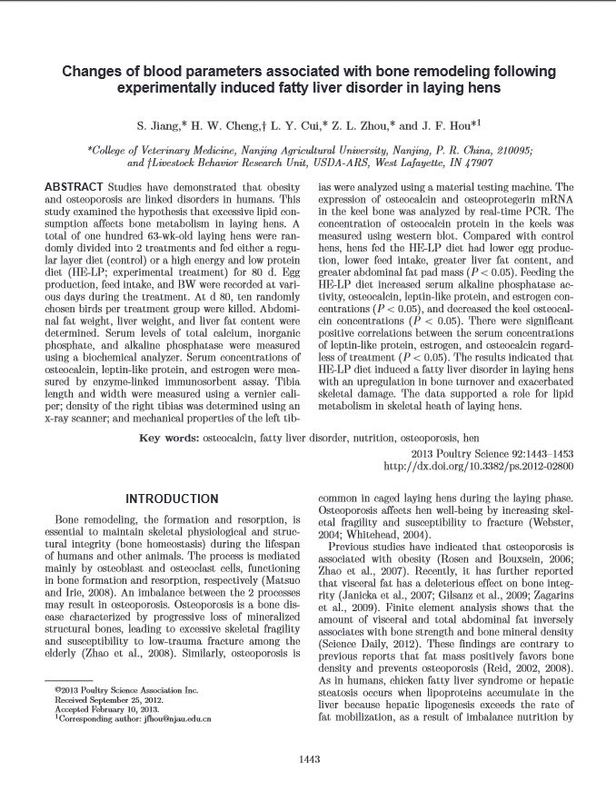Changes of blood parameters associated with bone remodeling following experimentally induced fatty liver disorder in laying hens
Title
Changes of blood parameters associated with bone remodeling following experimentally induced fatty liver disorder in laying hens
Date
Subject
Excerpt
Studies have demonstrated that obesity and osteoporosis are linked disorders in humans. This study examined the hypothesis that excessive lipid consumption affects bone metabolism in laying hens. A total of one hundred 63-wk-old laying hens were randomly divided into 2 treatments and fed either a regular layer diet (control) or a high energy and low protein diet (HE-LP; experimental treatment) for 80 d. Egg production, feed intake, and BW were recorded at various days during the treatment. At d 80, ten randomly chosen birds per treatment group were killed. Abdominal fat weight, liver weight, and liver fat content were determined. Serum levels of total calcium, inorganic phosphate, and alkaline phosphatase were measured using a biochemical analyzer. Serum concentrations of osteocalcin, leptin-like protein, and estrogen were measured by enzyme-linked immunosorbent assay. Tibia length and width were measured using a vernier caliper; density of the right tibias was determined using an x-ray scanner; and mechanical properties of the left tibias were analyzed using a material testing machine. The expression of osteocalcin and osteoprotegerin mRNA in the keel bone was analyzed by real-time PCR. The concentration of osteocalcin protein in the keels was measured using western blot. Compared with control hens, hens fed the HE-LP diet had lower egg production, lower feed intake, greater liver fat content, and greater abdominal fat pad mass (P < 0.05). Feeding the HE-LP diet increased serum alkaline phosphatase activity, osteocalcin, leptin-like protein, and estrogen concentrations (P < 0.05), and decreased the keel osteocalcin concentrations (P < 0.05). There were significant positive correlations between the serum concentrations of leptin-like protein, estrogen, and osteocalcin regardless of treatment (P < 0.05). The results indicated that HE-LP diet induced a fatty liver disorder in laying hens with an upregulation in bone turnover and exacerbated skeletal damage. The data supported a role for lipid metabolism in skeletal heath of laying hens.
Relation
Poultry Science
Volume 92, Number 6
pp. 1443-1453
 An official website of the United States government.
An official website of the United States government.


